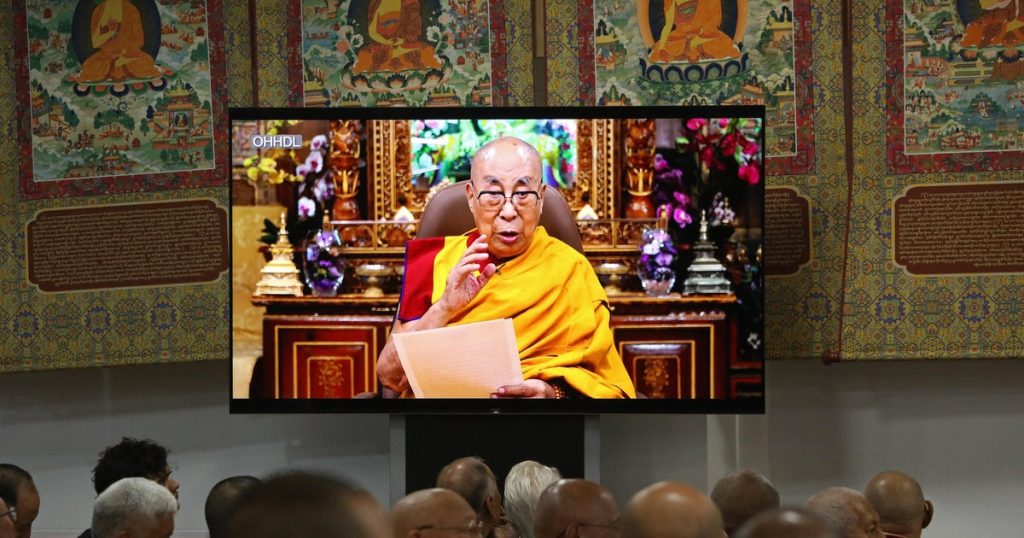The Dalai Lama declared on Wednesday that the Tibetan Buddhist institution will persist after his passing, concluding speculation concerning his potential status as the final leader in the role. During a prayer celebration organized ahead of his upcoming 90th birthday, he emphasized that the search for his successor must adhere to traditional Buddhist practices. Moreover, he firmly stated that the Chinese government should not interfere in determining the next Dalai Lama, a figure revered by many as a manifestation of compassion.
| Article Subheadings |
|---|
| 1) The Dalai Lama’s Announcement |
| 2) China’s Stance on Succession |
| 3) The Role of the Gaden Phodrang Trust |
| 4) Reactions from the Tibetan Community |
| 5) The Process of Identifying a Successor |
The Dalai Lama’s Announcement
During a gathering in Dharamshala, India, the Dalai Lama reaffirmed that the tradition of the Dalai Lama will continue even after his death. This statement comes at a pivotal time as he approaches his 90th birthday, a moment many consider significant for consolidating the spiritual leader’s legacy. He underscored the importance of identifying his successor through historical religious protocols, asserting the family’s and spiritual community’s role in that decision. His statement served as a comfort for many Tibetans who regard his leadership as vital for the endurance of their cultural identity and Buddhism in Tibet and the diaspora.
China’s Stance on Succession
The announcement from the Dalai Lama is poised to irritate the Chinese government, which has long claimed authority over the selection process for the next Dalai Lama. Chinese officials maintain that they would play a crucial role in identifying the future leader, which they assert must be recognized within the confines of Tibet’s territories governed by the Chinese Communist Party. By promoting this narrative, the party hopes to ensure that any successor aligns with their ideological views, which has raised concerns among Tibetan Buddhists and human rights advocates. The tensions between the Dalai Lama’s acknowledgment of past traditions and the Chinese government’s alleged intention to control such an appointment further emphasize the ongoing struggle for Tibetan autonomy.
The Role of the Gaden Phodrang Trust
In his declaration, the Dalai Lama indicated that the process for recognizing his reincarnation will rest solely with the Gaden Phodrang Trust. This non-profit organization, which he established in 2015, has been tasked with overseeing matters pertinent to his position as the spiritual leader. According to him, this trust will carry the weight of responsibility for maintaining the integrity of the succession process, ensuring it adheres to past traditions without external interference. “No one else has any such authority to interfere in this matter,” he stated, clearly delineating the boundaries of the trust’s authority vis-à-vis the Chinese government’s encroachment.
Reactions from the Tibetan Community
Penpa Tsering, the president of the Tibetan government-in-exile, expressed profound gratitude for the Dalai Lama’s assurances about the future of the institution. At a recent press conference, Tsering emphasized that Tibetans worldwide firmly wish for the Dalai Lama’s legacy to endure for the benefit of all sentient beings and Buddhists in particular. He further called for the global Tibetan community to unite in rejecting any candidates chosen by Beijing, reiterating that this matter is unique to Tibetan Buddhism and should not be exploited for political gain. This sentiment echoes a broader understanding among many Tibetans about the potential ramifications of China’s involvement.
The Process of Identifying a Successor
The intricate process of identifying the next Dalai Lama typically begins only after the current leader passes away. In the past, senior monks have engaged in prayers, spiritual signs, and visions to locate the child believed to be the reincarnation of the Dalai Lama. Traditionally, this process can be extensive, taking several years to culminate in the final identification and subsequent acclimatization of the successor to fulfill their role. The complexities of this tradition highlight not just the deep spiritual significance of the Dalai Lama’s position but also the challenges posed by external political forces.
| No. | Key Points |
|---|---|
| 1 | The Dalai Lama affirms the continuity of the Tibetan Buddhist institution after his death. |
| 2 | China claims it alone has the authority to approve the next Dalai Lama. |
| 3 | The Gaden Phodrang Trust is responsible for identifying and recognizing his reincarnation. |
| 4 | Tibetan leaders urge unity against Chinese interference in the succession process. |
| 5 | The identification of a successor involves traditional methods and can take several years. |
Summary
The Dalai Lama’s proclamation regarding his succession marks a significant moment in determining the future of Tibetan Buddhism and its leadership. By redirecting the focus to traditional practices and outlining the role of the Gaden Phodrang Trust, he aims to safeguard the institution’s integrity against external political pressures, particularly from China. As the anticipation builds within the Tibetan community about the next leader, the challenges surrounding the identification process underscore the delicate balance between spirituality and politics, a theme deeply intertwined with Tibet’s historical struggles for autonomy.
Frequently Asked Questions
Question: What does the Dalai Lama’s announcement mean for Tibetans?
The Dalai Lama’s announcement assures Tibetans that their spiritual leader will be succeeded in accordance with traditional practices, preserving their identity and beliefs amid political pressures from China.
Question: Who is responsible for identifying the next Dalai Lama?
The responsibility of identifying the next Dalai Lama lies with the Gaden Phodrang Trust, a non-profit organization established by the current Dalai Lama.
Question: How does China view the selection of the next Dalai Lama?
China asserts that it has the authority to approve the next Dalai Lama and expects the reincarnation to be found within its Tibetan regions, emphasizing its desire to control the succession process.


